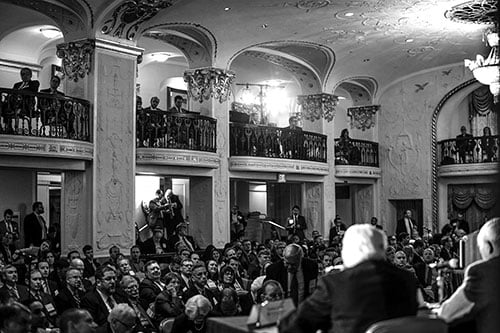Facts of the Case
The Defense of Marriage Act (DOMA), enacted in 1996, states that, for the purposes of federal law, the words "marriage" and "spouse" refer to legal unions between one man and one woman. Since that time, some states have authorized same-sex marriage. In other cases regarding the DOMA, federal courts have ruled it unconstitutional under the Fifth Amendment, but the courts have disagreed on the rationale.
Edith Windsor is the widow and sole executor of the estate of her late spouse, Thea Clara Spyer, who died in 2009. The two were married in Toronto, Canada, in 2007, and their marriage was recognized by New York state law. Thea Spyer left her estate to her spouse, and because their marriage was not recognized by federal law, the government imposed $363,000 in taxes. Had their marriage been recognized, the estate would have qualified for a marital exemption, and no taxes would have been imposed.
On November 9, 2010 Windsor filed suit in district court seeking a declaration that the Defense of Marriage Act was unconstitutional. At the time the suit was filed, the government's position was that DOMA must be defended. On February 23, 2011, the President and the Attorney General announced that they would not defend DOMA. On April 18, 2011, the Bipartisan Legal Advisory Group of the House of Representatives filed a petition to intervene in defense of DOMA and motioned to dismiss the case. The district court denied the motion, and later held that DOMA was unconstitutional. The U.S. Court of Appeals for the Second Circuit affirmed.
Questions
Does the executive branch's agreement with the lower court that the act is unconstitutional deprive the Supreme Court of jurisdiction to decide the case?
Does the Bipartisan Legal Advisory Group of the House of Representatives have standing in the case?
Does the Defense of Marriage Act, which defines the term "marriage" under federal law as a "legal union between one man and one woman" deprive same-sex couples who are legally married under state laws of their Fifth Amendment rights to equal protection under federal law?
Conclusions
-
No, unanswered, yes. Justice Anthony M. Kennedy delivered the opinion of the 5-4 majority. The Supreme Court held that the United States Government, despite the executive branch's agreement regarding DOMA's unconstitutionality, retains a significant enough stake in the issue to support Supreme Court's jurisdiction. Because the judgment in question orders the U.S. Treasury to refund tax money, the Government stands to suffer a real economic injury and therefore maintains standing in the case. The Bipartisan Legal Advisory Group (BLAG) presented substantial arguments for the constitutionality of DOMA that reflected an actual controversy under Article III, which allowed the Supreme Court to address the case without needing to decide whether BLAG would have had standing before a lower court. The Court also held that states have the authority to define marital relationships and that DOMA goes against legislative and historical precedent by undermining that authority. The result is that DOMA denies same-sex couples the rights that come from federal recognition of marriage, which are available to other couples with legal marriages under state law. The Court held that the purpose and effect of DOMA is to impose a "disadvantage, a separate status, and so a stigma" on same-sex couples in violation of the Fifth Amendment's guarantee of equal protection. Chief Justice John G. Roberts wrote a dissent in which he argued that the Court lacked the jurisdiction to review the case and that interests in uniformity and stability justified Congress' enactment of DOMA. He also argued that the majority's opinion did not address the issue of state definitions of marriage affecting same-sex couples. In his separate dissent, Justice Antonin Scalia wrote that the Supreme Court had neither the jurisdiction to review the case nor the power to invalidate democratically enacted legislation. He argued that the majority's opinion wrongly asserted the supremacy of the Supreme Court as the final arbiter of government. However, the majority opinion did not address the issue of whether or not the Equal Protection Clause required laws restricting the definition of marriage to be reviewed under a rational basis or strict scrutiny standard. He also argued that the majority misconstrued DOMA's insidious intent and should not rule based on that presumption. Justice Clarence Thomas and Chief Justice Roberts joined in the dissent. Justice Samuel A. Alito, Jr. also wrote a separate dissent in which he argued that the United States Government did not have standing in the case because the executive branch declined to defend the statute, but that BLAG did have standing because it chose to defend the otherwise undefended statute. He also argued that the Constitution does not guarantee the right to enter into a same-sex marriage because that right is not "deeply rooted in this Nation's history and tradition." Instead, the issue of the definition of marriage is left to the people to decide, a decision in which DOMA does not interfere. Justice Clarence Thomas partially joined in the dissent.
The ABA and United States v. Windsor
ABA Watch August 2013
Since 2004, the American Bar Association has formally opposed federal actions that ban or limit...
Same-Sex Marriage: A Variety of Perspectives on United States v. Windsor and Hollingsworth v. Perry
Engage Volume 14, Issue 1 February 2013
Decoding the Constitutional Challenges to Traditional Marriage By John C. Eastman* On December 7, 2012,...
Hollingsworth v. Perry and United States v. Windsor - Post-Decision SCOTUScast
SCOTUScast 7-8-13 featuring Carrie Severino and Jonathan Adler
On June 26, 2013, the Supreme Court announced its decision in Hollingsworth v. Perry and United...
History and Recent Development in Same-Sex Marriage Litigation
Engage Volume 15, Issue 1
Note from the Editor: The purpose of this article is to provide a comprehensive national survey...
Thoughts on the New Constitutional Case Against Obamacare
On February 26th, twenty Republican-controlled states filed a lawsuit challenging the constitutionality of the Affordable Care...
The Court Decides: The Prop 8 and DOMA Cases - Podcast
Federalism & Separation of Powers Practice Group and Religious Liberties Practice Group Podcast
On June 26th, the U.S. Supreme Court decided two same sex marriage cases: the Proposition...
Do State Attorneys General Have a Duty to Defend State Laws? - Podcast
Federalism & Separation of Powers Practice Group Podcast
Recently U.S. Attorney General Eric Holder, citing the Supreme Court's 5-4 decision in United States...
Engage Volume 14, Issue 1 February 2013
The Journal of the Federalist Society Practice Groups
*Online Only Issue CIVIL RIGHTS Same-Sex Marriage: A Variety of Perspectives on United States v....
Countdown to the National Lawyers Convention: What's "Conservative" about the "Roberts" Court?
Next week, I will participate in the Federalist Society’s National Lawyers Convention, in Washington, D.C.,...
Bullet-Point Summary of Masterpiece Cakeshop, Ltd. v. Colorado Civil Rights Comm’n.
SCOTUS decided Masterpiece Cakeshop this morning. The opinion may be found here: https://www.supremecourt.gov/opinions/17pdf/16-111_j4el.pdf (1) The vote...
ABA Watch August 2013
Table of Contents
ABA Watch has a very simple purpose—to provide facts and information on the Association, thereby...
An Originalist Future
Engage Volume 15, Issue 1
Note from the Editor: This article discusses the originalist method of constitutional interpretation. As always, The...
Redressing Politicized Spending
Engage Volume 15, Issue 1 February 2014
Note from the Editor: This article is about politicized spending in the federal discretionary budget. ...
The Race Card in ARPA’s Food Supply Deck
Federalist Society Review, Volume 22
It is an old aphorism that a prudent person should not watch the making of...
United States Supreme Court Term in Review
BlackFinn American Grille 1910 Bagby StreetHouston,
Litigation Update: Same Sex Marriage at the Supreme Court
Sitti 137 S. Wilmington StreetRaleigh,












